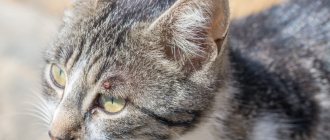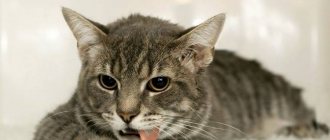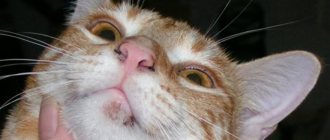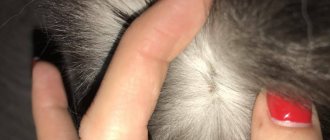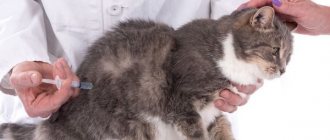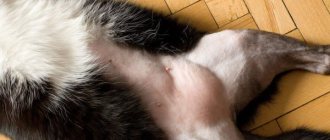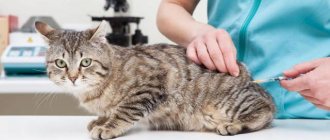If a cat’s ear is leaking, then pet owners should not ignore such signs, as they can be a signal of serious problems. Brown or clear liquid in the area of the ear canals may indicate an inflammatory process; such a manifestation is the result of mechanical damage. If there is a problem, contact a veterinary clinic, where a specialist will conduct a comprehensive examination and select the necessary treatment.
Mechanical injuries: wounds, scratches, abrasions
They arise due to strong mechanical stress.
As a rule, they are the result of “March games”, as well as fights with other cats. Most often, lesions of this type are either bitten or torn. They are subject to abundant contamination with pathogenic and conditionally pathogenic microflora, which is why they become severely inflamed and fester profusely. This is precisely the reason for the existence of many homeless animals, from whose ears only small “stubs” remain.
Symptoms and treatment
Diagnosing such injuries is simple: they are easily detectable visually, and their signs are hard to miss. The doctor must only determine the severity of the inflammatory process. If the latter is especially severe, purulent or ichorous exudate is released, and a sample of pathological material is taken. It is used for microscopic examination and seeding on nutrient media. It is necessary to accurately determine the type of pathogen in order to prescribe adequate and effective therapy.
By the way, how are these injuries treated? In mild cases, it is sufficient to treat the affected ear(s) with hydrogen peroxide followed by the application of iodine or brilliant green.
This treatment at home leads to a pronounced positive result within a couple of weeks.
If the inflammatory process is severe and the case is advanced, surgical treatment of the affected surface will most likely be required. Dead tissue is carefully cut out. Sometimes cats have to undergo a forced procedure of ear cropping: to ensure that the edges of the ears are smooth and neat, and not “frayed” and uneven, it is better to immediately trim and trim them.
The edges of the wound are carefully tightened with sutures. To do this, they try to use materials that dissolve in the body over time (i.e., there is no need to remove sutures).
When a cat’s condition is severe due to a widespread inflammatory process, there is lethargy, refusal to feed and elevated body temperature, the animal is prescribed broad-spectrum antibiotics and other antimicrobial drugs.
If the wound continues to fester, you need to carefully soak and remove crusts of dried exudate daily using a cotton swab and hydrogen peroxide. If this is not done, maceration (softening) of the skin and coat will occur. The ears will become bald, which will not make your pet particularly attractive. But it’s much worse that the bare areas themselves can become inflamed, which will further complicate and worsen the process.
Diagnostics
When a stink appears from an animal's ear, it is recommended to begin the diagnosis with a visual examination. To see better, you can shine a flashlight into your ear.
What you should be wary of:
- strong smell of rot;
- smells like rotten meat;
- pus, black, brown discharge;
- blood, scabs;
- redness of the skin.
It is impossible to make an accurate diagnosis at home. For any alarming symptoms, contact a specialist.
Veterinarian actions:
- taking a blood test to identify the inflammatory process;
- examination using an otoscope;
- ear smear, bacteriological analysis of discharge;
- biopsy (used as a last resort).
If necessary and the disease is severe, the cat is left for treatment at a veterinary clinic. In milder cases, the doctor prescribes medications for home therapy .
How to identify ear mites:
- Discharge from the ears has a brown tint.
- The cat constantly shakes his ears and does not allow himself to be stroked.
- Body temperature rises, the animal becomes lethargic and restless.
- In the acute stage of the disease, touching the ears causes pain and tremors in the hind legs.
- Test: Use a cotton swab to take a small amount of discharge and shake it onto a black sheet of paper. If white moving dots appear, this is an ear mite.
Timely treatment prevents unpleasant consequences, hearing loss. The tick can cause inflammation of the brain, leading to death.
Anatomy of the ears of cats and cats
The ear is the organ of hearing and balance. It consists of outer, middle and inner.
The outer ear includes the pinna (the visible part of cartilage covered by skin, fur, or hair) and the ear canal. The ear canals of cats and kittens are deeper and more conical than those of humans. This deeper canal is prone to the accumulation of dirt and wax, leading to inflammation and secondary infections.
Cats' hearing is many times more sensitive than humans'.
The middle consists of the eardrum and an air-filled chamber that contains 3 tiny bones, 2 muscles, the oval window and the eustachian tube.
The inner ear is a complex structure that includes the cochlea (the organ of hearing) and the vestibular system (the organ of balance).
Anatomy of a cat's ear
In what cases is it necessary to contact a veterinarian?
Since otitis media is an extremely dangerous disease, it is necessary to pay attention to any strange and alarming behavior of the cat. Here are the cases in which you will need to contact a veterinarian:
- The animal clearly shows signs of damage to the vestibular apparatus (the animal cannot maintain stability, falls out of the blue, etc.).
- Pets that are experiencing neurological seizures should be taken immediately to the veterinarian. These signs indicate damage to the central nervous system.
- You also cannot do without the help of a specialist in cases where the animal completely refuses food for a day or more. In addition, it is urgent to take the cat to the doctor if the pet does not drink.
- Veterinary care is required for cats suffering from unbearable pain and itching.
- In addition, it is necessary to contact the clinic if the animal is too apathetic, does not react to anything, or lies flat.
What reasons should be excluded first?
If your cat’s ears are leaking, it’s best not to guess, but to immediately take your pet to the veterinarian. Without cytological, microscopic and histological examination it is impossible to make a diagnosis. At the appointment, the veterinarian will examine the ear canal, get acquainted with the existing symptoms (usually itching, discharge, foul odor, redness, etc.), and collect the discharge to carry out the necessary diagnostic measures to confirm or exclude the following possible causes:
- Ear mite. The most common cause of various types of ear problems in cats. Characteristic symptoms usually include redness of the inside of the ear, peeling, foul odor and severe itching. Brown liquid with an unpleasant odor may also flow from both ears. Infection occurs through close contact with an infected animal or objects with which it has been in contact. If treatment is not started in time, there is a high probability of complications of the process with a bacterial infection, since due to severe itching the animal will constantly scratch the temple area until there is blood and sores. To make a diagnosis, discharge from the ear canal is taken for cytological examination and deep plucks from both ears for microscopic examination. If a tick is detected, then medications are selected for treatment, which are applied to the animal’s withers or buried inside. Complete recovery is considered to be the complete absence of mites in the last scrapings.
- Foreign body. If a cloudy fluid resembling pus flows from a cat’s ear, then the possibility of a foreign body getting inside should be ruled out. Outdoor pets have a risk of getting plant seeds, branches from trees or bushes into the ear canal. Pets most often suffer from food or plants they have access to (cacti) getting inside their ears. In most cases, a foreign body is accompanied by an inflammatory process (purulent otitis), which can only be eliminated by removing the splinter from the auricle and carrying out symptomatic treatment. Since, in addition to the discharge, there is almost always a foul odor from one organ of hearing and severe itching. You can also tell that something is wrong with an animal by the squelching sounds that can be heard when it shakes its head. If a cactus needle, the remnant of another animal’s claw, or a twig that you can get out yourself has gotten under your skin, you can use tweezers pre-treated with a chlorhexidine solution to remove it. But, in most cases, the veterinarian still has to remove the foreign body from the cat’s ear canal using special gripping tools. He will also select anti-inflammatory and antibacterial drops that will help prevent the development of bacterial otitis.
- Allergy. For the most part, this is a problem with decorative breeds, which suffer from food allergies and atopic dermatitis from birth. Allergic otitis is quite common in Maine Coons, Exotics, Persians and Sphynxes. Characteristic symptoms are the appearance of dirty discharge with an unpleasant odor inside the ear, redness of the skin and peeling. There may be sores and sores in the area of the temples and the outer side of the ear, as a result of scratching due to severe itching. You need to understand that allergic otitis media is treated symptomatically during an exacerbation. It is not possible to completely recover from it. In some cases, switching to holistic food or other medicinal, hypoallergenic foods helps a lot. The most difficult thing is in cases of atopic dermatitis, since the potential allergen can even be contained in house dust or mold, which is almost impossible to exclude from everyday life.
- Fungal and bacterial infection. We specifically brought these two diseases together, since there are many known cases where a cat has a fungal infection in one ear and a bacterial infection in the other. That is why, to make a diagnosis, it is recommended to take discharge for cytological examination from both ears. After identifying the pathogen, effective drugs (ointments, tablets) are selected.
If an old cat has a leak from one ear, then it is better not to delay a visit to the veterinarian, as this may be the first sign of the development of a tumor process inside the auricle.
Signs of the disease
The very first signs of otitis media that should alert the owner is the pet's anxiety. The cat often scratches or touches the sore ear with its hind paw, presses the tip of the shell, shakes its head and tilts it.
Otitis externa
Inflammation in the external auditory canal is easy to detect. Upon visual inspection of the shell, redness of the skin and slight swelling of the tissues are noted. The ear feels hot to the touch. Otitis externa in a cat is indicated by the presence of scratches, ulcers and wounds on the auricle.
Atypical gray-yellow discharge, pus or a dark mass may be found inside - a sign of infection with ear scabies.
Otitis media and internal
If the disease progresses and spreads to the middle and inner ear canal, the signs of malaise become more pronounced. Symptoms of otitis media in a cat:
- pain when touching the ear - the pet does not allow itself to be touched and meows pitifully;
- increased body temperature;
- loss of interest in food;
- lethargy, depressed state;
- the cat walks with its head tilted towards the sore ear and often shakes it;
- with purulent otitis media, yellow-green exudate with a foul odor is released from the shell;
- with severe intoxication of the body, vomiting may begin;
- The cat jumps up sharply when it feels a sharp shooting pain.
With advanced otitis media, the facial nerve is sometimes involved in the inflammatory process, then the eyelid and lip of the cat sag on the side of the diseased ear.
Otitis media can become chronic. In this case, the cat shows anxiety periodically when the disease worsens. Thickened skin around the ear is one of the signs of a chronic course. Chronic otitis media often develops if the owner does not know how to treat otitis media in a cat and does not contact a veterinarian.
Specific symptoms
Some symptoms help suggest the underlying cause of otitis media:
- If a cat has rashes on its body, this suggests that the disease has developed due to an allergy.
- When ear mites become the cause of the inflammatory process, a dark brown mass is found inside the ear canal.
- Liquid discharge from the ear indicates that the inflammation is caused by water getting inside the shell.
- If otitis is caused by a fungal or bacterial infection, then it is accompanied by the release of a cloudy yellow exudate, while the cat's ears are hot.
- If, during a veterinary examination, a tumor is found in the shell, then it can be assumed that it was this that triggered the onset of the inflammatory process.
Prevention
To prevent the development of ear diseases in cats, owners must systematically examine their pet’s ears and clean the ears from excess wax and plaque. To carry out hygienic procedures, you can use special preventive solutions, hydrogen peroxide. You should not treat your cat’s ears with alcohol solutions, much less instill medicinal or hormonal medications for preventive purposes. The procedure should be carried out only with sterile gauze and cotton pads and ear sticks. Use a separate blank disk for each ear.
Ear cleaning
Avoid hypothermia or prolonged exposure of animals to drafts. When bathing your pet, to prevent water from getting into the ears, you can purchase special ear swabs or close the ear canal with a cotton pad. After swimming, check to see if any water has entered the ear.
Cat scratching its ear
In addition, you need to pay attention to the state of the immune system, introduce multivitamin, mineral complexes and supplements into the diet. If the general condition worsens, noticing the above symptoms of ear diseases, show the cat to a veterinarian
We invite you to join our Zen channel and group on VKontakte or Odnoklassniki, where new articles for pet owners are published.
Medicines for otitis media
Treatment of otitis is carried out using systemic and local drugs. The prescription list includes medications recognized in veterinary medicine. Basic therapy can be supplemented with traditional medicine. To achieve a positive result, it is important to follow the treatment regimen and duration of the course prescribed by the veterinarian.
Medicines of official medicine
To sanitize the auricle and external auditory canal, use sterile gauze wipes soaked in an antiseptic solution. Boric acid (3%), chlorhexidine, hydrogen peroxide (3%), furatsilin, miramistin are suitable for this purpose. If the eardrum is not damaged, then drops for otitis media can be used for treatment:
- Sofradex;
- Dexamethasone;
- Aurikan;
- Uricin;
- Surolan;
- Anandin;
- Otibiovet;
- Tsiprovet;
- Tsipam;
- Otovedin.
Otibiovet
The medicine comes in the form of clear drops. The dropper bottle can have different volumes - 20, 30 or 50 ml. The drug is used for otitis of the external and middle ear. Active substances (gentamicin sulfate, triamcinolone acetonide, salicylic acid, carbetopendicinium bromide) act against bacteria and fungi. Drops reduce itching, discharge, and reduce the manifestations of dermatitis.
Surolan
An oily suspension containing miconazole nitrate, polymyxin B sulfate, prednisolone acetate. This is a combined drug that has anti-inflammatory, antibacterial, fungicidal, and antiallergic effects. The volume of the bottles is 15 or 30 ml.
If otitis in cats is caused by bacteria or they are a secondary cause of inflammation, systemic antibacterial drugs are prescribed. The use of these medications is also justified for fungal otitis in order to prevent infection by bacterial microflora. The list includes:
- Amoxiclav;
- Ampicillin;
- Amoxicillin;
- Cefazolin;
- Ceftriaxone;
- Cefixime;
- Erythromycin;
- Clarithromycin;
- Azithromycin;
- Spiramycin.
Ampicillin
global $ads_google; //data-ad-slot=”2475549904″ $ads_google = empty($ads_google) ? false : true; ?> if ($ads_google == false) {?>
$ads_google = true; ?> } ?>
Semi-synthetic drug of the penicillin series. Available in the form of tablets and powder for suspension. The medicine has a broad antimicrobial effect. The tablets are given to the cat on an empty stomach or 2 hours after eating.
Cefixime
Semi-synthetic antibiotic from the group of cephalosporins in tablets or powder. Active against many pathogenic bacteria. Used to treat otitis media in the acute stage. Not suitable for small kittens and sick elderly pets.
To treat integuments affected by parasitic fungi, fungicidal ointments are used: Panolog, Oridermil, Clotirmazol, Nystatin. In some cases, MycoStop ProVET antifungal drops are indicated. Complex therapy includes vitamin-mineral complexes and immunomodulators (Imunofan, Ribotan). They help the cat's body resist infection.
Folk remedies
Additional support for otitis media in cats is also provided by traditional medicine recipes. They are easy to prepare and use at home. The most harmless solution is considered to be a solution made from strong green tea. The filtered tea leaves are used to wipe the cat's ears. This product has a disinfectant and acaricidal effect. An infusion of herbs with antibacterial and anti-inflammatory effects has a similar effect. Chamomile, string, lavender, birch leaves, and St. John's wort are suitable for processing.
Frequently asked questions about the treatment of otitis media in cats
Question: In what cases may surgical intervention be required?
Answer: In case of advanced inflammation, purulent, to eliminate blockage of the ear canal.
Question: For which otitis media can antibiotics be used?
Answer: They are prescribed only when an infection occurs. In particular, with bacterial, purulent, fungal otitis media.
Question: What happens if otitis media is treated incorrectly?
Answer: This leads to serious complications (for example, perforation of the eardrum, infection in the brain, development of meningitis).
Question: What happens if otitis media is not treated at all?
Answer: Then the inflammation will intensify and the cat’s temperature will rise. When the infection affects the brain, the animal will become deaf. In the worst case scenario, this can lead to the death of your pet.
Possible causes of ear disease
Any disease of the auricle is dangerous, as it can lead to complete deafness of the cat and even death. This is due to the fact that the structure of a cat’s ear is very complex, reminiscent in complexity of the human structure, i.e. has internal, middle and external sections. Therefore, inflammatory processes can penetrate to the cat’s brain.
Let's consider the course of some diseases and the causes of their occurrence.
Otodectosis
A disease caused by ear mites. It is sometimes called ear scabies.
It is caused by a tick. It is impossible to see this creature without special devices. Therefore, in this case, a doctor is needed who will conduct an external examination and take an analysis. This disease is quite contagious, so if there are other animals in the house, it is better to remove the one with ear pain.
The tick digs into the thin skin on the cat's ear as it feeds on blood and lymph. The cat begins to scratch its ears, from which a brown liquid is released. It dries out and turns into small crumbs. And even if you clean your cat’s ears every day, there will be no effect. New discharge will appear again and again. Therefore, it is necessary to add treatment prescribed by a doctor to home treatments. The cat's owner will need to treat the cat's ears with a solution of hydrogen peroxide or camphor alcohol, and then apply drops prescribed by the doctor. The course can take from 7 to 10 days.
Hematomas, lymphatic extravasation, abscesses
Any injury to the ear can cause a hematoma, for example, a bruise, a bite, etc. Outwardly, it will look like swelling, the cat's ears will look droopy, and the site of the hematoma will look hot. Only the inside of the cat's ear should be carefully examined, because... hematomas on the outside are very rare. The cat becomes nervous and even aggressive, scratching its ears and constantly shaking its head. Similar ear diseases in cats can lead to severe complications, and in some cases to cartilage necrosis.
Trauma accompanied by the penetration of a pathogenic infection into it can lead to an abscess. Outwardly, it looks a little like a hematoma, but pus accumulates inside. At the same time, the cat’s ear hurts so much that she can bite hard during examination.
Another disease very similar to hematoma is lymphatic extravasation. But in this case, a bubble with liquid (blood or lymph) forms. Any of the listed manifestations of injury requires contact with specialists.
Otitis
This is an inflammatory process that forms in the auricle. This is perhaps the most difficult and painful condition for a pet. With otitis media, a cat's ears may become swollen, the shell will become red, hot, and an unpleasant odor will emanate from inside. In a severe, advanced form, the cat's eyelid may close and the lip may sag. The cat will begin to show strong aggression and will look for a dark, secluded place. How to treat a cat’s ears is necessary to find out from a specialist, since any self-medication will only cause harm and will aggravate the pet’s condition and can lead to complications.
Entry of foreign objects
Such items include sand, particles of plants, insects, sulfur plugs, etc. Some objects may get into a cat's ears without being noticed, but others can irritate the surface of the ear. The cat begins to scratch its ears, trying to free itself from the disturbing object, as a result of which it can injure itself. In some cases, the object itself can cause inflammation.
Neoplasm
Often, signs of pain in the ears can be caused by papilloma, sarcoma or fibroma. These tumors are very dangerous because, growing in the cat’s ear, they clog the entrance to the auricle, which can lead to deafness. Doing it yourself in this situation costs nothing; you should urgently contact a specialist.
Treatment of otitis media in cats at home
Self-treatment of otitis in cats without first consulting a veterinarian is unacceptable. You cannot use drops, ointments and other means at your own discretion. Incorrect therapy can lead to complications or a chronic course of the disease.
What you can do on your own
If you can’t visit a veterinary clinic in the near future, you can do the following:
- examine the cat, feel the ears to understand whether they hurt or not;
- remove excess hair around and on the inside of the shells with scissors;
- soak the crusts with a solution of boric acid, Chlorhexidine or Miramistin and carefully remove with a clean cotton pad;
- Treat wounds and scratches with an antiseptic and apply Levomekol ointment;
- drop 2-3 drops of one of the drugs - Otipax or Otinum - inside the ear canal to relieve pain and itching.
What not to do
Mistakes when manipulating a cat's ears can result in disaster. Before visiting a veterinary clinic, you should not clean your pet’s ear canals with ear sticks. With otitis media, the pain is very severe. The cat will resist anyway. One awkward move and you might accidentally poke your ear with a stick.
It is not recommended to use hydrogen peroxide for treating the ear canals. Upon contact with biological fluids, it begins to hiss. This sound may frighten a cat.
Attention! If you have otitis media, it is prohibited to warm your ears, because dry heat will increase the proliferation of pathogenic bacteria.
How to properly clean your ears
Before introducing therapeutic drops for otitis into the ear canal, the ears are always cleaned. This procedure is fairly painless, but you will still need the help of another person. It should secure the cat and hold its paws and head.
If no one is nearby, you will have to wrap your pet's body tightly in a blanket. Before doing this, you need to prepare cotton pads, as well as lotion for treating sinks.
How to properly clean your ears:
- Slightly straighten the ear to open the ear canal.
- Soak a cotton pad in a special lotion.
- Carefully remove all contaminants in the external auditory canal; do not penetrate deeper.
- Apply lotion, squeeze the ear at the base and massage so that the product is distributed inside.
- Treat the second sink in the same way.
Attention! You cannot use cotton swabs!
A special lotion is the safest way to clean your ear. It is enough to drip the required amount of product, massage the sink for 1 minute and let the pet shake its head. After this, you need to wipe the inside of each ear with cotton pads to remove any remaining dirt and crusts.
Expert opinion
Chepa Natalya Semenovna
Veterinarian
Ask a Question
Among cats, fold-eared breeds are most prone to otitis, because... they have a small closed ear and a narrow ear canal that is poorly ventilated. Hairless breeds produce a lot of sulfur, which can also be a predisposing factor for the development of otitis media. A common mistake owners make when caring for their ears is using a cotton swab. It will not be possible to clean the ear well with a cotton swab due to its structure, but leaving the cotton swab, “compacting” the wax inside the passage and causing irritation of the skin of the ear canal is quite likely. For home care, it is best to use special lotions no more than once a month. You should not use multi-component ear drops on your own. Medications should be prescribed by a doctor based on a cytological examination.
Causes
Hearing diseases occur for the following reasons:
- blockage of the ear canal
- infectious diseases;
- arthropods;
- allergic reactions;
- mechanical damage.
Ear canal blockage
The most common cause of otitis. Indicates improper care of the owners. The canal becomes clogged with earwax or water. The following cat breeds are predisposed to developing blockages:
recommended articles:
- Siamese;
- orientals;
- sphinxes.
Excessive care for your pet leads to otitis media. During bathing, water clogs the passage, creating optimal conditions for the development of anaerobic organisms - bacteria or fungi.
Sphynx cats are prone to ear diseases
Infectious diseases
Bacterial or fungal infections are secondary. Conditionally pathogenic microflora is always present on the surface of the ear. The fight against pathogens weakens the immune system, secondary flora multiplies in the ear canal and causes otitis media. If leakage is detected, the ears are cleared of exudate and Aurican or Surolan drops are used.
Aurikan
Arthropods
Flea bites are accompanied by scratching, and the wound surface is a breeding ground for microbes. The infection penetrates into the medial ear, where anaerobic conditions favor the development of putrefactive microflora.
Otodectes ear mites cause no less harm to a cat's health. They gnaw passages in the skin. The resulting defects are filled with blood serum, which dries and spills out of the ear. Treatment consists of cleaning the ear canal and using drops that have anti-inflammatory, acaricidal and antiseptic effects.
Allergic reactions
Irritants inhaled or consumed in food cause allergic rashes. The cat scratches the itchy areas, and bacteria and fungi multiply on them. If left untreated, the infection penetrates into the middle ear and causes purulent otitis media.
Allergic lesion
Mechanical damage
Most often, ear injuries are the result of a showdown between cats. The mechanism of development of purulent inflammation is the same as for the above reasons - penetration of infection.
Causes
The development of otitis media in cats is facilitated by various factors – primary and secondary. The inflammatory process in the ears usually develops against the background of reduced immunity. For this reason, the disease is most often diagnosed in kittens and older cats. After all, it is their body that is weakened and unable to fight pathogens.
Primary factors
The primary causes of the development of otitis in cats are those factors that provoke the onset of the inflammatory process. These include:
- Hypothermia. Draft and dampness are the most dangerous enemies of cats. If water accidentally gets into the ear, then over time, pathogenic microorganisms begin to multiply inside - streptococci, staphylococci, etc. A cat with a strong immune system will not develop otitis media, however, the protective functions may be weakened by hypothermia. In this case, the likelihood of developing an inflammatory process will increase significantly.
- Foreign objects or neoplasms. When a foreign body enters the ear canal, the removal of wax secretion becomes difficult. Microbes begin to multiply inside. The same thing happens when a tumor occurs in the ear canal. The cat feels discomfort and begins to scratch its ear. Thus, the animal further aggravates the situation - scratching can get infected, which provokes otitis media.
- Fungus. The risk of developing otitis media increases if the cat suffers from skin fungal diseases.
- Allergy. The main cause of inflammation in the ears of allergic cats is itching. They constantly scratch the shells, injure the external auditory canal, which leads to otitis media.
- Injuries, insect bites. Cats that often go for walks often injure their ears on branches of bushes and other objects, and they are also sometimes attacked by wasps and ticks. Abrasions, scratches and insect bites are gateways through which infection enters the skin. To prevent the development of the disease, any damage to the skin of the ears must be treated with an antiseptic.
- Densely growing fur on the ears. When overgrown hairs get inside the sink, they cause discomfort. The cat is itchy, so it often scratches itself with its paw. When the skin is damaged by claws, pathogenic bacteria enter the wound and inflammation occurs.
- Autoimmune diseases. Their essence is that the animal’s immune system perceives the cells of its own body as foreign and fights them. This process is always accompanied by inflammation.
- Hormone imbalance. Failure of the endocrine system leads to health problems. The cat's metabolism is disrupted and its immunity is reduced. This may cause the onset of an inflammatory process.
Secondary factors
Secondary factors in the development of otitis in cats include bacterial and fungal infections, which complicate the course of the disease. For example, Malassezia mushrooms, which live on the skin and mucous membranes of cats, usually do not pose any danger. However, allergies, diseases of the endocrine system, and decreased immunity can provoke their rapid growth. In this case, the animal will begin an inflammatory process.
Also, external otitis is often complicated by pathogenic bacterial microflora - streptococci, staphylococci or Escherichia coli.
Causes of otitis media and deep
The development of inflammation in the middle or inner ear is not always preceded by external otitis media. Sometimes the disease immediately develops directly in these parts of the ear canal. This happens in the following cases:
- with injury to the temporal bone or the area of the skull that is located near the ear;
- due to damage to the integrity of the eardrum due to a strong blow or loud noise;
- with a malignant or benign tumor that has grown and penetrated inside the ear canal.
Treatment
It will be difficult to get rid of the problem on your own, but you can relieve pain in the following ways:
- Regularly wipe the ear and leaked fluid with antiseptic solutions. The product needs to be warmed up a little, and the instruments must be sterile.
- Special drops are instilled several drops per day. After examination by a veterinarian, the exact dosage is prescribed, which is determined individually.
- Novocaine blockade promotes rapid recovery and relieves pain.
Specific measures are taken depending on the cause of otitis media. For example, if the problem is ear mites and the cat’s ear has become infected, then acaricidal drops intended for cats are used. For fungal infections, fungicides are used. The use of antibiotics is prohibited, otherwise the fungus will begin to spread more rapidly.
They are prescribed only if an infection is detected, which is accompanied by copious dark yellow discharge. Surgery is required when it is necessary to pierce the eardrum and completely treat the ear with an antiseptic. Treatment of otitis caused by hormonal imbalances or allergies is carried out through the use of immunostimulating and anti-stress medications.
Treatment methods
After examining the cat with an otoscope and taking material from the ear, the veterinarian will prescribe preliminary treatment. It will be adjusted once the test results are received. The regimen and tactics of therapy will depend on the reasons that contributed to the onset of the inflammatory process.
If the disease is mild and the pet’s life is not in danger, then it is treated at home. In severe cases, when there are symptoms of intoxication or there is a risk of developing meningitis, it is better to leave the cat in a hospital under the supervision of a doctor.
Standard treatment includes:
- pain relief – most often this is an injection;
- cleaning the ear canals from pus and crusts;
- injection of medicinal drops into the sore ear;
- For purulent otitis, the cat is prescribed a course of antibiotic injections.
A sick pet must be provided with complete rest. It is kept in a warm, draft-free place.
Therapy tactics
Regardless of the cause of inflammation, treatment of otitis in a cat begins with eliminating the symptoms. If only the outer ear is affected, then the shell is wiped with a special lotion and lubricated with wound-healing ointment daily until complete recovery.
For otitis media, veterinarians prescribe anti-inflammatory drops and painkillers by injection. It is important to provide your cat with adequate nutrition. Vitamins are added to the food to support immunity.
For purulent otitis, veterinarians prescribe local broad-spectrum antibacterial drops with anti-inflammatory and analgesic effects, as well as vasoconstrictor drugs. They relieve swelling, so pus comes out of the ear freely.
Attention! To prevent the cat from scratching its ears, a protective collar is put on during treatment.
Surgical intervention is not necessary if the eardrum is perforated or if a tumor is found in the ear.
Specific treatment
After receiving the test results, the veterinarian may change the treatment regimen and tactics. From now on, medications will be selected taking into account the primary cause of ear inflammation:
- If ear mites are the cause of otitis, the cat will be prescribed acaricidal drops.
- If a fungal infection is detected, the doctor will recommend antifungal medications.
- If the disease occurs due to allergies, antihistamines will be included in the treatment regimen.
- If there is a hormonal imbalance that leads to inflammation in the ears, it is recommended to take corticosteroids.
- To treat otitis media complicated by a bacterial infection, the doctor will prescribe antibiotic injections plus antimicrobial drops.
Medicines for the treatment of otitis media
All types of otitis are treated comprehensively. The following groups of drugs are usually used in the treatment of ear diseases:
- hygienic lotions for cleaning sinks;
- antimicrobial solutions for external treatment;
- wound healing ointments;
- analgesic, vasoconstrictor, antifungal, acaricidal and antibacterial drops;
- complex action antibiotics in the form of injections;
- antihistamines.
Since the main reason for the development of otitis media is a weakened immune system, many veterinarians recommend including immunostimulating drugs in the treatment regimen.
Most often, for otitis media, the following drugs and medications are used:
- Antiseptics for external treatment - a solution of furatsilin, boric acid or hydrogen peroxide.
- Wound healing ointments with antimicrobial effect - Levomekol, Safroderm.
- Drops with analgesic and anti-inflammatory effects - Otipax and Otinum.
- Antimicrobial drops - Anandin, Polyseptin, Otibiovet, Otibiovin, Sofradex.
- Antifungal drugs - MykoStop.
- Drops for parasitic otitis – Decta and Amitrazine.
- Combined drugs for the treatment of complicated otitis, including parasitic ones - Otospectrin, Tresaderm, Otidez, Oritsin, Surolan.
- Antihistamines are used for otitis of an allergic nature - these are Cetirizine, Tavegil, Loratadine.
- For bacterial otitis, cats are prescribed intramuscular injections of antibiotics - Amoxiclav, Cefixime or Ceftriaxone. The dosage is determined by the veterinarian taking into account the weight of the animal. Treatment lasts 7 days.
The cat has an earache
When your pet's ears hurt, you need to go to the veterinarian
Why this is important, why ear diseases are dangerous in cats and how they are treated, you will soon find out.
The cat has pain in the ears and head: causes, common symptoms and behavior
If a cat has ear pain, this can be understood from its behavior. He starts shaking his head and tries to scratch his ears. Liquid with an unpleasant odor may be released from the ears.
There are two main causes of cat ear problems - otitis media and otodectosis. Their treatment is different. The diseases are dangerous and, if left untreated, can lead to deafness and even death.
If your cat has ear pain, how to treat it at home
The best treatment is the one prescribed by the doctor after determining the cause of the disease. For otitis, you need ear drops containing an antibiotic or anti-inflammatory, and for otodectosis, acaricidal drugs.
Ear treatment should take place in three stages: - cleansing the ear canals; — instillation of medications prescribed by a doctor;
- strengthening the immune system.
For otitis, complex drops help - Otibiovin, Otonazole, Otibiovet, Aurikan, etc. For purulent otitis, antibacterial drugs are prescribed intramuscularly - penicillins, macrolides or cephalosporins.
The kitten has pain in his ears, his ears are shaking, how to help - folk remedies
You cannot treat a kitten’s ears with folk remedies. When using medications prescribed by a doctor, treatment started on time always ends successfully.
When proper drug therapy is delayed, the eardrum of the ear is perforated and the inner ear parts become inflamed. In the most pessimistic scenario, brain inflammation will begin and the animal will die.
The cat has an ear ache inside what to cure, otitis media, shakes his head what to drip
To decide how to treat cat ears with otitis media, you need to find out the cause of the disease. It can be very different: - ear mites; - inflammation of the gums or caries; - bacterial infection; - allergies;
— congenital pathology, etc.
After examining the animal, the veterinarian will prescribe appropriate treatment. You may need surgery if you self-medicate and progress the disease.
In case of allergies, he will prescribe antihistamines and anti-inflammatory drops; in case of gum inflammation and caries, the cat’s teeth will need to be treated. Bacterial otitis may require intramuscular injections of antibiotics, and for ear scabies caused by mites, acaricidal drugs cannot be avoided.
In the initial stage of the disease, the cat scratches its ear and shakes its head. If foul-smelling fluid begins to be released from the auricle, it means that the disease is progressing. With purulent otitis, simple anti-inflammatory drops in the ears will not help.
Of the drugs containing antibiotics, Anandin is used. Gramicidin C, which is part of it, is active against certain pathogens. Place the drug in the ear, 3 drops two or three times a day for a week. Before instillation, be sure to clean the external auditory canal with a cotton swab.
A cat has sores on its ears, how can it be cured, if the ear is swollen or it’s like a ball, can it be pierced?
Accumulation of fluid under the skin of the ear is possible with a small hematoma on the ear. The cat could have injured itself by scratching its ear. The wound became infected and fluid accumulated under the skin.
You can’t pierce a swollen ear yourself
It is important that the cavity in which the accumulation of pus occurs is disinfected
This can only be done by a doctor in a veterinary clinic using sterile instruments, using antiseptics and antibiotics.
The cat's ears hurt and there are sores with blood on the ears, blood is flowing, it smells like pus with blood
The reason that a cat scratches its ear until it bleeds can be various diseases: otodectosis, allergies, purulent otitis, foreign objects getting into the ear, polyps, cancer, traumatic brain injuries. If your cat scratches its ear until it bleeds, or purulent discharge appears, you should immediately visit the veterinarian.
The cat has an earache and a strong unpleasant odor from there from the ears and itchy, watery eyes
An unpleasant odor from the ears and increased attention from the animal to them always indicate the presence of otitis media. What causes otitis, only a doctor can tell you during an examination at a veterinary clinic
One examination is not enough; tests will be taken from the cat. Only with this approach will the treatment be successful.
The doctor will prescribe ear drops that will not only relieve inflammation, but will also be able to overcome the cause of its occurrence, which can be very different. Drops of Bars, Tsipam, Otovedin will help with otodectosis. In advanced cases, treatment is prescribed in combination with antibiotics.
Diagnostic activities
If your cat's ear stinks and there is unpleasant discharge, you should consult a veterinarian. Such a violation is the result of a serious infection and other dangerous diseases. To determine the source of the problem, laboratory and instrumental examinations are carried out. To examine the ear canal, the veterinarian uses an otoscope, through which it is possible to identify inflamed areas and the extent of the disorder. During diagnosis, the following facts are revealed:
- presence/absence of foreign objects in the ears;
- benign or malignant neoplasms;
- condition of the eardrum.
If certain pathologies are suspected, a smear is taken from the cat's ear, followed by laboratory examination under a microscope. Thanks to this diagnostic procedure, it is possible to identify bacteria, fungi and other pathogenic microorganisms that may cause an inflammatory reaction. After a comprehensive examination, hormonal, antiallergic and other medications are selected, after taking which the cat’s ear will stop leaking.

